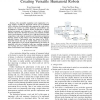Free Online Productivity Tools
i2Speak
i2Symbol
i2OCR
iTex2Img
iWeb2Print
iWeb2Shot
i2Type
iPdf2Split
iPdf2Merge
i2Bopomofo
i2Arabic
i2Style
i2Image
i2PDF
iLatex2Rtf
Sci2ools
ICRA
2006
IEEE
2006
IEEE
The Task Matrix: an Extensible Framework for Creating Versatile Humanoid Robots
— The successful acquisition and organization of a large number of skills for humanoid robots can be facilitated with a collection of performable tasks organized in a task matrix. Tasks in the matrix can utilize particular preconditions and inconditions to enable execution, motion trajectories to specify desired movement, and references to other tasks to perform subtasks. Interaction between the matrix and external modules such as goal planners is achieved via a high-level interface that categorizes a task using its semantics and execution parameters, allowing queries on the matrix to be performed using different selection criteria. Performable tasks are stored in an XMLbased file format that can be readily edited and processed by other applications. In its current implementation, the matrix is populated with sets of primitive tasks (eg., reaching, grasping, arm-waving) and macro tasks that reference multiple primitive tasks (Pick-and-place and Facing-and-waving).
ICRA 2006 | Matrix | Performable Tasks | Primitive Tasks | Robotics |
| Added | 11 Jun 2010 |
| Updated | 11 Jun 2010 |
| Type | Conference |
| Year | 2006 |
| Where | ICRA |
| Authors | Evan Drumwright, Victor Ng-Thow-Hing |
Comments (0)

